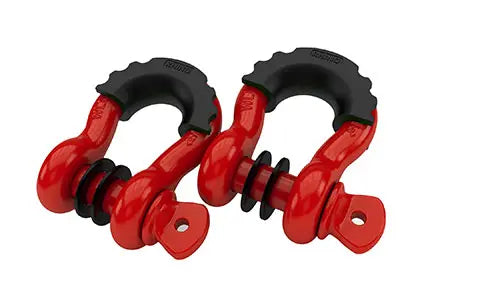
Kinetic Recovery Rope Explained
Have you been thinking about adding a kinetic recovery rope to your personal arsenal of recovery gear, but are not totally sure of how it works or if it is necessary? No need to worry, we’ll do our best to put all of your unsure thoughts at ease.
Featured Product: Rhino USA Kinetic Recovery Rope
How does a kinetic rope work?
A kinetic recovery rope, also sometimes called a snatch or yanker rope are stretchy ropes used to recover stuck vehicles. They are able to recover these vehicles by stretching and effortlessly transferring kinetic energy. If you are used to using a non-stretch rope to recover your vehicle, such as a tow strap, you may be thinking that using a stretchy rope may seem a little strange or non-functional, but trust us when we say that they are extremely effective and have lots of other benefits as well.
By using a recovery rope with stretch, the rope tends to have a longer lifespan and be much more durable than your non-stretch rope. Along with this, the stretch also helps with the general recovery of your vehicle by being great at absorbing shock. These ropes can also be incredibly helpful when you are in the snow, mud, or even sand due to the ability to leave slack in the rope.
Another benefit to having a kinetic recovery rope is that a smaller vehicle will actually be able to recover a larger vehicle because the kinetic recovery rope is able to give both parties an extra bit of power. The kinetic recovery ropes are able to stretch up to 30 percent of their length, which in turn helps the recovery go a little more smoothly on both vehicles as well.
What size kinetic rope do I need?
If you plan on recovering a larger vehicle, it is best to figure out the gross vehicle weight of the vehicle that needs to be recovered by four, then search for your rope based on the best fit for that number. The last thing you need when recovering a vehicle is a rope with a minimum breaking load that is way too low for the job.
We have put together a super easy-to-understand kinetic rope guide to help you better decide what size kinetic rope you need for your vehicle

Once you have found the proper kinetic recovery rope, you are one step closer to being able to recover a vehicle. To actually perform a recovery, be sure to check and see that there is nothing in the way of the vehicle that needs to be recovered. This will help ensure everyone’s safety and the additional safety of the vehicles. Once you have done this, attach your kinetic recovery rope to both vehicles by their proper recovery point. Using an improper recovery point can lead to severe damage or potentially be very dangerous.
After you have done this, be sure that any parties around have moved away from the vehicles to a safe distance so you are able to safely perform the recovery. The unstuck vehicle can begin with slack in the line and start to drive no more than five miles per hour. It is important to have a driver in the vehicle that is being recovered as well to help guide the vehicle and help with additional grip.

If a kinetic recovery rope seems like something that you would like to add to your recovery kit, check out Rhino USA’s Kinetic Energy Recovery Rope. The recovery rope comes in two sizes, ⅝”x 20’ and ⅞” x 20’. The ⅝” rope has a max break strength of 13,436 lbs and the ⅞” rope has a max break strength of 24,660 lbs. It is made of heavy duty synthetic fiber for extended durability and also comes with a lifetime warranty and a sticker pack!
 Kinetic rope FAQ's
Kinetic rope FAQ's
Where to buy a kinetic recovery rope?
Rhino USA offers a range of high-quality kinetic ropes designed to excel in off-road recovery situations. If you are looking to buy the best kinetic recovery rope, Rhino USA offers kinetic ropes from 5/8" x 20' up to 1.25" x 30'
How much does a kinetic recovery rope weigh?
The weight of a kinetic rope depends greatly on the size of kinetic rope. A 7/8" x 20' weighs approximately 8.5 pounds, whereas a 1.25" x 30' kinetic rope weighs 21.5 pounds. The 1.25" x 30' rope is thicker in diameter and 10 feet longer, therefore, it has a much higher weight.
- Choosing a selection results in a full page refresh.








